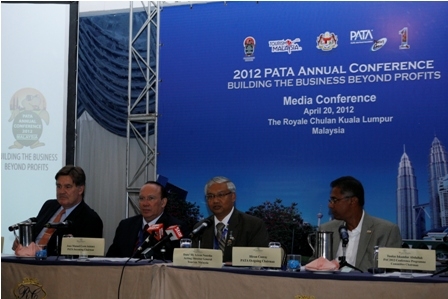Tourism in Malaysia

Excerpts from YAB Tan Sri Muhyiddin Yassin, Deputy Prime Minister’s speech at the Opening of the PATA Annual Conference 2012, Kuala Lumpur, on 21 April 2012:
The United Nations World Tourism Organisation (UNWTO), in its forecast of international tourist arrivals reaching 1 billion tourists by 2012, and 1.8 billion by 2030, has indicated that the Asia and the Pacific area will gain most of the new arrivals. In addition, Asia and Pacific countries will have an increased share of the global tourist market, from 22% in 2011 to 30% in 2030.
Even today, the charm of Asia and the Pacific still remains irresistible to many. In 2011, 217 million international tourists came to the Asia Pacific; compare this to the 22 million in 1980! Malaysia is similarly fortunate to have its fair share of the global tourism market. In 2011, we received 24.7 million tourists. This was a far cry from a little more than a decade ago, when we received only 7 million tourists in the year of 1999.
The region is set to capture a bigger share of the tourist market with UNWTO forecasting about 540 million tourists traveling to the region by 2030. On this note, I am happy to share that Malaysia was ranked 9th most visited country in the world for the past 3 years, i.e. 2009 to 2011.
Based on 2011 reports, tourism is currently the seventh largest industry contributing to the Gross National Income (GNI) after Oil, Gas and Energy, Wholesale and Retail, Palm Oil and Rubber, Financial Services, Agriculture and Electrical & Electronics sectors.
In fact, the main contribution of exports of services in 2011 is the result of income earned from travel by foreign tourists to Malaysia with a value of RM55.2 billion (USD18.4 billion) or 51.7% of the total exports of services. The imports of travel-related services amounted to RM25.7 billion (USD8.6 billion) or 22.4% of total imports of services. Therefore, travel-related services recorded a surplus of RM29.5 billion (USD9.8 billion), which signifies the importance of tourism to the Malaysian economy.
Moreover, Malaysia’s vibrant tourism industry provides employment for 1.8 million people, where 15.9% of total employment is from the tourism sector.
In recognition of the growth potential of tourism in Malaysia, the Malaysian Government has acknowledged it as one of 12 high-growth industries, or National Key Economic Areas (NKEA), to kickstart the Government’s Economic Tranformation Programme (ETP). Twelve Entry Point Projects have been identified to spur the growth of the industry between now and 2020, providing almost half a million job opportunities. By 2020, the tourism industry is expected to contribute RM103.6 billion (USD34.53 billion) in Gross National Income, with arrivals increasing to 36 million in that year.
Among Malaysia’s most popular tourism offerings is the Malaysian Homestay tourism experience. There are 150 homestay clusters located all over Malaysia, with 3,211 operators offering 4,309 rooms. A programme initiated by the Government, the homestay experience brings tourists back to the roots of Malaysian culture and lifestyle in the countryside. For the tourist, it is an authentic experience of a lifestyle so far-removed from the modern trappings of city life which is rustic yet charming, full of warmth and sincerity. For the villages involved in these homestay operations, the income goes straight back to the local communities supporting this venture. In 2011, revenue generated from the homestay programme alone was RM15.74 million (USD 5.2 million).
The Government also acknowledges the gravity of threat that our world is under. Climate change is one of the biggest concerns of tourism today, and the United Nations World Tourism Organisation has warned of its severe threats on tourism industries worldwide – sea-level rise, loss of crop yields and extreme weather condition, among them, which have direct impacts on tourism and its niche products.
At last month’s Second Asia-Pacific Climate Change Adaptation Forum in Bangkok, the Asian Development Bank revealed that as many as 42 million people in the region were displaced by environmental disasters in the last two years. It would take as much as USD40 billion a year through 2050 for Asia Pacific countries to prepare for the effects of climate change.
On this note, I am pleased to share with you that Malaysia was recently recognized as the third best in Asia Pacific and 25th best among 132 countries worldwide last year in the Environmental Performance Index. The country’s EPI position in 2010 was 54th among 163 countries around the world and sixth in the Asia Pacific region. Among the aspects evaluated for the EPI were climate change, water and air pollution.
Other initiatives by the Ministry of Tourism to promote sustainable tourism:
The Malaysia Business Tourism Green Programme known as “Let’s Meet and Green” was also initiated in support of the Government’s commitment to offset carbon emissions by 40% by the year 2020 specifically by business tourists to Malaysia.
There is also the “Plant a Tree” (PAT) programme to encourage homestay tourists to “give back” to nature, as well as the 1Malaysia Green, 1Malaysia Clean (1MG1MC) campaign to encourage Malaysians to care for our environment. To date, 10,000 trees have been planted.
The Malaysian Government has also urged its hoteliers to make concrete efforts to be responsible towards the environment. They have been urged to adopt the “Green Hotel” classification of accommodations according to the ASEAN Hotel Standards. Already, ten of our Malaysian hotels have received the ASEAN Green Hotel Awards in 2011 for their efforts in environmental conservation. On-going training and awareness programmes are conducted to hoteliers to advise and assist them of the criteria for these awards.
The ten hotels that received the ASEAN Green Hotel Awards are The Andaman Langkawi; Shangri-La Tanjung Aru Resort and Spa, Kota Kinabalu (Sabah); Shangri-La Rasa Ria Resort, Tuaran (Sabah); Shangri-La Rasa Sayang Resort and Spa (Penang); Shangri-La Hotel Kuala Lumpur; The Frangipani Langkawi Resort and Spa; Nexus Resort Karambunai (Sabah); Hotel Melia Kuala Lumpur; The Mines Wellness Hotel, Selangor; and Renaissance Kuala Lumpur Hotel.















